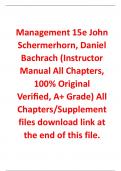Management 1 5e John Schermerhorn, Daniel Bach rach (Instructor Manual All C hapters, 100% Original Verified, A+ Grade) All Chapters/Supplement files download link at the end of this file. Schermerhorn / Management 1 5th Edition Instructor’s Guide 1-1Chapter 1 MANAGEMENT , MANAGERS, AND CAREERS Learning Objectives In studying this chapter, students should consider the following questions and be able to complete the accompanying objectives: Learning Objective 1.1: Summarize the challenges of developing and maintaining career readiness in today’s economy. Learning Objective 1.2: Describe what organizations are like as work settings. Learning Objective 1.3: Discuss what it means to be a manager. Learning Objective 1.4: Explain the functions, roles, and activities of managers. Learning Objective 1.5: Summarize how we learn and use essential skills for career success . Overview Work in today’s economy is increasingly knowledge based, and people, with their capacity to bring valuable intellectual capital to the workplace, are the ultimate foundation of organizational performance. The chapter begins with a section on understanding the challenges of working today. The world of work is undergoing dynamic and challenging changes that provide great opportunities along with tremendous uncertainty. These changes are due to the impact of important trends regarding worker talent, technological change, globalization, ethical standards, workforce diversity, and careers. After setting up this framework for the changing environment in which organizations operate, the chapter goes on to describe organizations as open systems which interact with their environments in the process of transforming resource inputs in to finished goods and se rvices as product outputs. From this point, the bulk of the chapter describes m anagers and their work ; detailing that m anager s directly support, supervise, facilitate and help acti vate the work efforts of other people in organizations. Next, the chapter explore s the management process consisting of the four functions of planning, organizing, leading, and controlling , followed by the roles and skills managers need for success. The chapter concludes with a discussion of the essential managerial skills and how they are lea rned. Lecture Outline Teaching Objective: To increase awareness of how a dynamic and changing environment affects organizations, managers, and the management process in the new workplace. . Schermerhorn / Management 15th Edition Instructor’s Guide 1-2 Suggested Time: Two hours of class time are typically required to present the material in this chapter. Learning Objective 1: Summarize the challenges of developing and maintaining career readiness in today’s economy. Talent Technology and Analytics Globalization Ethics and Governance Diversity, Equity and Inclusion Careers and Self-management Learning Objective 2: Describe what organizations are like as work settings. Organizational purpose Organizations as systems Organizational performance Changing nature of organizations Learning Objective 3: Discuss what it means to be a manager. What is a manager? Levels of managers Accountability and Managerial performance Changing nature of managerial work Learning Objective 4: Explain the functions, roles, and activities of managers . Functions of management Managerial roles and activities Managerial agendas, networking, and social capital Learning Objective 5: Summarize how we learn and use essential skills for career success . Lifelong Learning and Learning Agility Management Skills Career Readiness Skills Supporting Materials Figures • Figure 1.1: Make Critical Thinking about Career Readiness Work for You • Figure 1.2: Passion, Culture, and Career Fulfillment • Figure 1.3: Organizations are Open Systems Interacting with Their Environments • Figure 1.4: Productivity and the Dimensions of Organizational Performance • Figure 1.5: The Manager’s Challenge – Fulfilling Performance Accountability while Depending on Others to do the Work • Figure 1.6: The Organization Viewed as an Upside-Down Pyramid . Schermerhorn / Management 15th Edition Instructor’s Guide 1-3 • Figure 1.7: Four Functions of Management – Planning, Organizing, Leading, and Controlling • Figure 1.8: Interpersonal, Informational, and Decisional Roles of Managers • Figure 1.9: Katz’s Essential Managerial Skills – Technical, Human, and Conceptual • Figure 1.10: Have You Got What It Takes? Soft Skills Quick Check • Figure 1.11: Using a Personal SWOT Analysis for Strategic Career Planning Thematic Boxes • Research Directions: Passion, Culture, and Career Choices • Ethics: Social Media Searches Linked with Discrimination in Hiring • Choices: Risk and Reward in a Two -Tier Workplace • Issues: Office Politics Don’t Disappear in Virtual Space • Insight: Soft Skills are Career Gold Management Learning Review • Summary • Self-Test Career Skills & Competencies • Evaluate Career Situations for New Managers: What Would You Do? • Reflect on the Self-Assessment: Career Readiness “Big 20” • Contribute to the Class Exercise: My Best Manager • Manage the Critical Incident : Team Leader Faces Test • Collaborate on a Team Project: The Amazing Great Job Race • Analyze the Case Study : Trader Joe’s: Managing Less to Gain More LECTURE NOTES WORKING TODAY Learning Objective: Summarize the challenges of developing and maintaining career readiness in today’s economy. Today’s working environment has changed dramatically due to the complex world in which we live. No longer can one be complacent, unskilled, or even expect job security. Innovation, cost competitiveness, and technology are the driving forces today. Career advancement today demands career readiness, which is the skills, competencies, aspirations, and goals that help a person in even rapidly changing environments. Employees also need initiative, self-
awareness, and continuous learning to upskill (continually update skills to keep them aligned with emerging job markets and new ways of working) and develop transferable skills (skills that apply across job types and occupations; for example, creativity, problem solving, communication, col laboration, and technology usage). .




